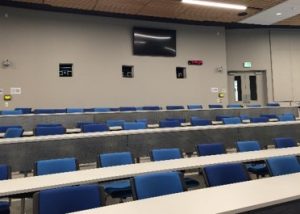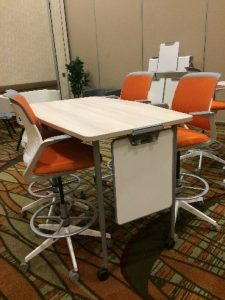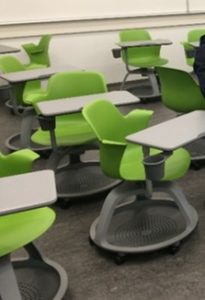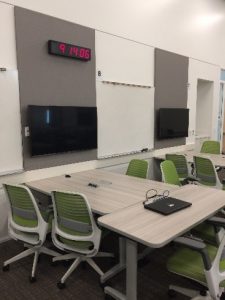Accelerate Active Learning by using Flexible Learning Spaces & Open Educational Teaching Materials – a SURF study trip recap
An important theme in today’s education and didactics is active learning. In active learning, students actively participate and engage in the learning process, contrary to the more traditional methods of passive instruction. Research shows that for proper learning to take place, it is necessary to process knowledge by giving it context and meaning, instead of merely listening and writing down (e.g. Prince, 2013). Furthermore, it has been shown that active learning increases examination scores and reduces the chance to fail (e.g. Freeman et al., 2014). Pedagogical approaches like class discussions, group activities, and gamification are typical for active learning.
During the ELI conference 2019 in Anaheim USA, the support of active learning was an important theme. Together with 14 colleagues from SURF and other institutions for higher education throughout the Netherlands, we joined this conference and also visited two universities, UC Irvine and UCLA, to find out how institutions in the USA support active learning. We learned that for the proper implementation of active learning, proper learning spaces combined with innovative technology and the right learning materials are very important. In this blog I want tell you more about this and how we experiment with learning spaces and open digital learning materials at the WUR.
Flexible Learning Spaces
The presence of flexible learning spaces is very important to stimulate a more active way of learning. Flexible learning spaces are (class)rooms (but can also be spaces in the library or the cafeteria) designed, furnished, and equipped with technology in such a way that they can easily be adjusted to the need of a teacher or student. This means that as a teacher, you can easily switch between different educational approaches; for example, switch from a plenary direct instruction to a more student-centred approach like group collaboration, project-based learning or a discussion. This also means an easy switch between roles, from an instructional to a more facilitating and coaching role.

For students, flexible learning spaces allow them to make more individual choices about their learning and to become more engaged. Students can choose if they want to work together in group learning spaces, retreat to an individual learning pod, or have a brainstorm session in a so-called break out room.

During the ELI conference and our visit to UC Irvine, we saw some inspiring flexible learning spaces and flexible class furniture. We saw fancy rolling chairs with a bag holder in it, large lecture rooms that could also be used for group work, and practical student rooms that could both be used as an individual concentration room as well as a collaboration room. But also very innovative classrooms specially made for collaboration, with technology that makes it very easy to switch between the group work and showing something plenary and walls that can be removed in 20 seconds. In these rooms we also saw that technique and tools play a significant role in the success of these flexible rooms (SURF, 2019). Furthermore, we learned that for a proper implementation of the learning spaces, it is very important to instruct the teachers about active learning didactics and how to use the flexible learning spaces technology. Teachers from UC Irvine, for example, have to fulfill an eight week course before even being allowed to use the collaboration rooms (SURF, 2019).


Interestingly, in the USA, University Libraries sometimes play a pioneering role in the development of flexible learning spaces. Some libraries, for example, provide rooms that can be used for both lectures and group work, but that, by simply opening up curtains before a green wall, can also be used as a video greenroom by students.
At WUR we are also experimenting with flexible learning spaces. In the WUR – Library we have a couple of rooms (the tower rooms) that can be used for both group work and individual learning. We also have places where students can relax, study places, and special focus areas.
In the Forum building we are experimenting with a collaborative learning space (rooms C0521 and C0525 in Forum). In these so-called We Connect rooms, groups can work together on their own screens, but the same screens can also be used for plenary information from the teacher.
Open Educational Teaching Materials
Another way to activate learning is the use of Open Digital Teaching Materials (ODTM). ODTMs are teaching materials published under an open license, which means the materials can be freely (re)used without asking permission to the maker.
In more traditional education, students use prescribed (digital) textbooks and learning materials on the Learning Management System (LMS). The teacher gives instructions on what parts of the books and materials should be used and when. For a more active form of learning, however, it is important that students are able to use the study material they like at the moment they need it (so called ‘just in time’). ODTMs can be used for this by both students and teachers. For example, students can use an ODTM (like an open knowledge clip), to get a better understanding of a topic. In more project-based learning the teachers can ask students to find the right material to finish their project on their own by searching for ODTMs, but also open access articles or open data. Also, if students are asked to give a presentation or lesson about a certain topic, ODTMs can play an important role.
The ELI study trip showed us that more and more institutions make it possible to find and (re)use their ODTMs. The UC Irvine, for example, made a lot of their lectures publicly available via an open license, and made them accessible via http://open.uci.edu/. A lot of students use these materials to enhance their learning, as you can see here. Because these lectures are open, students from other universities can also watch them. A colleague from Harvard showed us their search platform for (O)DTM called DART. Via this platform, materials from e.g. edX, youtube and soundcloud can be found. This platform enhances the use for (O)DTM in education by making it possible to directly couple material to their LMS (Canvas). At WUR, the Educational Support Center and the WUR Library made a similar platform for (O)DTM from the WUR, in which both teachers and students can find material: the Library 4 Learning.
All in all, the study trip to the ELI conference showed us some inspirational examples on the way US institutions support active learning pedagogy. We have to keep in mind though, that a proper implementation of active learning mainly depends on the didactical choices a teacher makes. Educating teachers in active learning strategies and didactics is therefore as important as the active learning tools themselves.
Want to know more about our study trip to the ELI conference, about flexible learning spaces or ODTM? Please check out the vlog of Barend, my colleague from Maastricht University or this publication from SURF. You can also check out our website or (when you have questions) contact the Servicedesk Library (+ 31 317 48 6666 or facilities.servicedesk@wur.nl).
Sources
Freeman, S., Eddy, S. L., McDonough, M., Smith, M. K., Okoroafor, N., Jordt, H., & Wenderoth, M. P. (2014). Active learning increases student performance in science, engineering, and mathematics. Proceedings of the National Academy of Sciences of the United States of America, 111(23), 8410-8415. doi:10.1073/pnas.1319030111
Prince, M. (2004). Does active learning work? A review of the research. Journal of engineering education, 93(3), 223-231.
SURF (2019) Active learning spaces: lessons learned in de VS. Retrieved from https://www.surf.nl/files/2019-05/Publicatie%20Lessons%20learned%20Active%20learning%20spaces.pdf
All pictures: shot by myself.
